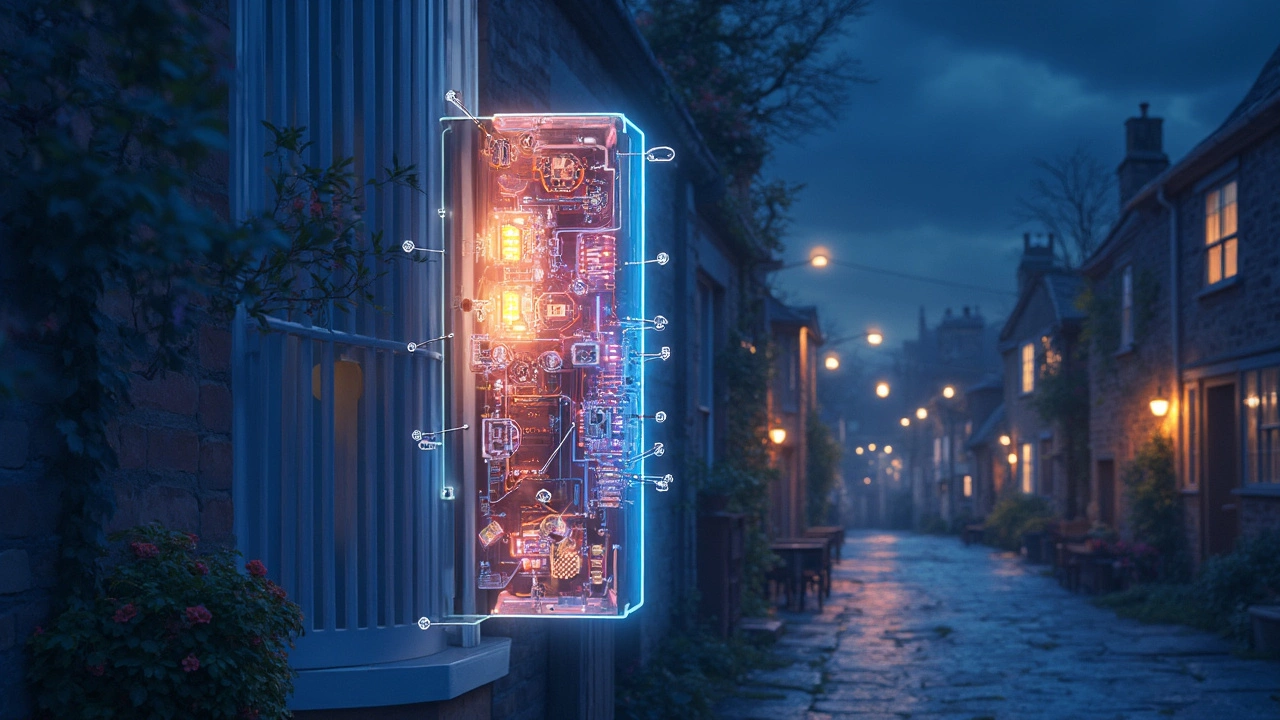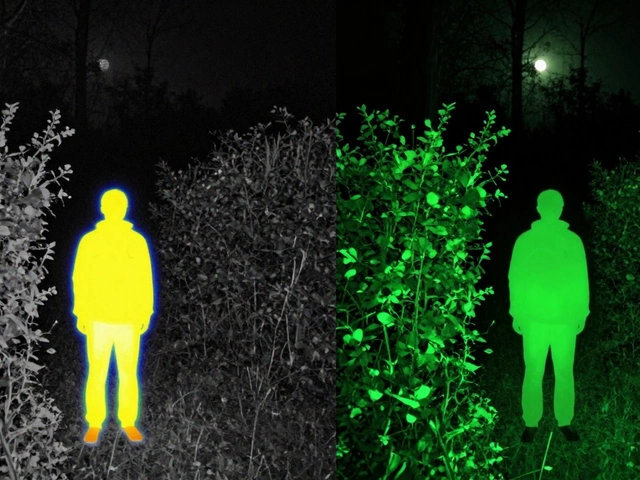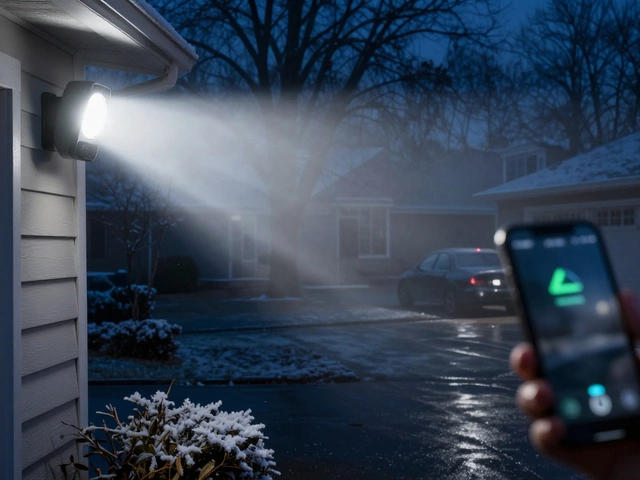So, you've got this new gadget, motion sensor lights, and you're wondering if they actually light up when it matters most—at night. Spoiler: they do! Motion sensor lights are basically like the guards of your home who never sleep. They're designed to detect movement and switch on in an instant, making them pretty sweet for home security, especially after the sun goes down.
But how do they do it? Well, these lights use sensors—most commonly infrared sensors—that pick up on changes in heat. When something or someone warmer than the ambient air, like a person or a car, passes by, the sensor picks up the heat change and flicks the light on. It’s like magic, but with science!
Now, if you think about it, these lights have to be real pros at their job when it's pitch dark. We'll dive into the techy stuff like how they work in low-light conditions and what might mess with their mojo. Stick around, because there's more to these bright helpers than meets the eye.
- How Motion Sensor Lights Detect Movement
- The Science of Nighttime Operation
- Common Challenges and Solutions
- Choosing the Right Sensors for Your Home
- Maximizing Effectiveness for Home Security
How Motion Sensor Lights Detect Movement
Alright, let's jump into the nitty-gritty of how these motion sensor lights actually catch you—or any sneaky intruder—moving around. The heart of these devices is their sensor mechanism, and trust me, it's pretty straightforward once you get the hang of it.
The most popular sensor type used in these lights is the Passive Infrared (PIR) sensor. What it does is detect infrared light emitted by objects, mainly living things like humans and animals. You see, every warm body emits a certain amount of infrared radiation, and the PIR sensor is tuned to notice this invisible heat signature change.
When something moves within its field, the sensor detects the sudden change in infrared energy against the usual background level. This triggers the light to turn on, alerting you to the movement. It's like having your personal home guardian that doesn’t bug you with unnecessary alarms.
Of course, they aren’t just limited to PIR. There are also microwave sensors, which emit microwaves and then measure the reflection of these waves off objects to sense movement. These babies can cover more ground but might pick up false alarms from tree branches swaying in the wind.
In some high-tech setups, you might find cameras that use video recognition to spot motion. This system can be more accurate but also more expensive. It's a trade-off between sophistication and simplicity.
And here's a little fun tip: If you're installing these lights at your place, position them where they have a clear view and are less likely to sense unwanted motion, like passing cars, which could drive you nuts with regular false activations.
The Science of Nighttime Operation
So, what's going on when those motion sensor lights click on at night? It's all about using sensors to pick up motion, even when it's dark out. Most of these lights have infrared sensors (PIR sensors), which detect infrared radiation—basically, the heat that living beings emit. When someone walks by, the sensor notices the change in heat and triggers the light.
Ever wonder if a motion sensor light can tell the difference between your neighbor’s cat and a burglar? They can! Most modern sensors include settings to adjust sensitivity, so you can set them to ignore small movements, like a kitty passing by, and only light up for bigger changes, like when someone approaches your driveway.
Dr. Emily Harper, an expert in home automation, puts it simply:
“Motion sensor lights have become smarter with advances in infrared technology, ensuring reliability at nighttime by accurately detecting movement and reducing false alarms.”
Now, about the actual light part—the sensors work with low-light-capable bulbs. LEDs are typically the choice for outdoor lighting because they’re bright, energy-efficient, and last forever (well, almost). Pair that with your trusty motion sensor, and you've got a sweet setup.
| Light Type | Efficiency | Lifetime (hours) |
|---|---|---|
| LED | High | 25,000+ |
| Halogen | Medium | 2,000 |
| Incandescent | Low | 1,200 |
If you’re setting these up, consider positioning them in strategic spots—not just by the front door, but maybe by the garage or any other shadowy spot too. The idea is to cover all your bases and make sure there are no sneaky dark spots left unattended. That’s how you get the most out of your home safety game.

Common Challenges and Solutions
Even the best motion sensor lights can run into a few hiccups, especially if they're working around the clock to keep your home safe at night. So, what kind of roadblocks might you face, and how can you tackle them?
One biggie is false triggers. You might find your lights going off when it's just a stray cat strutting through your yard—or even worse, when the wind sways your neighbor's tree right into view. This is where sensor sensitivity settings come in handy. Many models let you adjust how sensitive the sensor is. Too sensitive, and you’ll be living a disco life, not sensitive enough and, well, you'll be left in the dark.
"Adjusting the sensor’s sensitivity settings perfectly is key to ensuring reliable performance without constant false alarms," says lighting expert Maria Hansen.
Another challenge could be short battery life if you've opted for a battery-operated model. Some lights chew through energy faster than a teenager through a bag of chips. To fix this, go for LED bulbs as they're way more efficient and can save you trips to the store for replacements.
Interference can also be a party crasher. Things like Wi-Fi signals, heavy rain, or even dust buildup on the sensor lens can confuse the system. Regular cleaning and installing them away from other electronic devices can keep those false alarms at bay.
Finally, placement matters just as much as choosing the right lights. Put them too high, and they might not catch smaller movements. Too low, and they'll only light up half of what they’re supposed to cover. It's best to place them between 6-10 feet off the ground for optimal coverage.
- Test different sensitivity levels to find the sweet spot.
- Upgrade to LED bulbs for better energy efficiency.
- Regularly clean the sensor lens to avoid interference.
- Install lights at the right height for comprehensive coverage.
With these tweaks, your nighttime security can work like a charm – no gremlins in the system!
Choosing the Right Sensors for Your Home
Picking the right motion sensor lights for your place isn't a one-size-fits-all deal. There are a bunch of factors you gotta keep in mind. First up is the type of sensor technology. Most common ones are Passive Infrared (PIR) and Microwave sensors.
PIR sensors are great because they detect heat changes and are less likely to trigger false alarms caused by wind or moving leaves. However, if you have a bunch of pets running around, they might set these off. That's where Microwave sensors come in handy. They send out continuous waves and can detect movement through walls, which sounds high-tech, right? But they are more likely to go off without a real reason because they pick up on broader movements.
Another thing to think about is placement. Place them strategically to cover major entries like front doors, driveways, or those sneaky side paths. When positioning these sensors, height matters—it usually works best about 6-10 feet above the ground to catch those motion patterns just right.
Energy efficiency is another biggie. LED motion sensor lights not only save power but also tend to last longer, so they’re a win-win. You want these lights to last through the night and beyond.
"I always tell homeowners to look at both the technology behind the sensor and where they plan to install them," says security expert Sam Higgins, "Choosing the right setup can really make your security game stronger."
Don’t forget to check out the range and angle of the detection. Some sensors can sense movement from pretty far away or at a wide angle—great for covering large open areas. But you might want something more contained in a smaller yard.
Here’s a quick comparison to give you the bigger picture:
| Sensor Type | Benefits | Drawbacks |
|---|---|---|
| PIR | Accurate, Less False Alarms | Sensitive to Pets |
| Microwave | Detects Through Obstacles | More False Alarms |
By considering these factors, you can snag the perfect outdoor lighting that keeps your home safe and sound. Remember, the right motion sensor setup can be a game-changer for your home safety.

Maximizing Effectiveness for Home Security
Alright, let's talk about squeezing every bit of power from those motion sensor lights to boost your home security at night. If you're relying on them to be your home's silent night watchmen, there are a few tweaks and tricks to make sure they work their magic just right.
First up, position is everything. You want to install these lights where intruders are most likely to approach—side doors, back gates, and poorly lit areas. Don't just slap them anywhere; think like a sneaky burglar for a second and cover all the angles.
Next, sensitivity settings can make or break the effectiveness. Most motion sensor lights allow you to adjust how sensitive the sensor is. If it's too sensitive, you'll end up with lights flashing every time a leaf falls. Too low, and you might miss out on detecting actual threats. Find that sweet spot by testing a few options.
Timers are underrated but they play a big role. Decide how long you want the light to stay on once triggered. Typically, settings range from a few seconds to several minutes. The key is to make it short enough to save energy but long enough to alert anyone who should be aware.
Maintenance is another must-do. Clean the sensors regularly because dirt and cobwebs can affect their performance. It’s like giving your lights a breath of fresh air so they can continue to shine brightly without hiccups.
- Install lights at strategic points like entrances and dark pathways.
- Adjust the sensitivity settings for optimal detection.
- Set a reasonable timer to balance visibility and energy use.
- Regularly clean the sensors to maintain performance.
And if you want to get all nerdy, consider adding more security layers like camera systems that integrate with your motion sensors. This way, when the light goes on, you've got eyes on the scene too, becoming practically Sherlock-level vigilant.
Following these tips will help you light up your home better at night, keeping it safe, secure, and a beacon of peace in your neighborhood.






